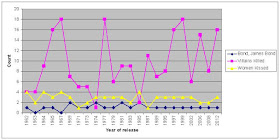According to the BBC article, the total number of villains killed is 218. Sixty-four women have been kissed, while 'Bond, James Bond' has been said 25 times. Over the 23-film series, an average of 9.5 villains have been killed per film, while each film has seen an average of 2.8 women kissed. 'Bond, James Bond' has been uttered an average of 1.1 times per film.
Looking at the individual Bond actors, Sean Connery's Bond has been responsible, on average, for the deaths of 9.3 villains. This compares with 7 villains for George Lazenby, 7.1 for Roger Moore, nine for Timothy Dalton, 12 for Pierce Brosnan, and 13 villains for Daniel Craig. These values suggest that there has been an increase over the course of the series in the number of villains killed per film. Notably, the standard deviation for Sean Connery (6.3 villains) is larger than that, say, for Pierce Brosnan (5.9), pointing to a more variable record for Connery's Bond. In other words, some of Connery's films have relatively few deaths (as few as four), while others are far more lethal, with as many as 18 deaths. The body count in Brosnan's films, by comparison, is generally higher (ranging from 8 to 18).
Turning to the number of women kissed, Sean Connery's Bond kissed on average three women per film. George Lazenby also kissed three women in his single film, and Pierce Brosnan's average is three as well. Roger Moore's Bond has a slightly lower average of 2.9 women kissed, and Daniel Craig's average is lower still – 2.3 women kissed per film. Timothy Dalton has the lowest average, just two women kissed per film, although Dalton's dataset of just two films is really too small for statistical purposes; after all, Dalton's Bond kissed three women in Licence to Kill, which is above the series average. As with the villains killed category, the standard deviation for Sean Connery is higher than that for Roger Moore (1.3 women kissed, compared with 0.7), suggesting that Connery's Bond is again the most variable (the range of Connery's Bond is between 1 and 4 women kissed).
Of the catchphrase, 'Bond, James Bond', there is very little variation across the film series; the phrase has more or less been uttered once in every film. The phrase, however, has not been used in every Connery film, and only George Lazenby and Roger Moore have used the phrase twice in a single film.

Some of the trends outlined above also emerge when we examine the data from a chronological perspective. From the chart, the general increase in the number of villains killed over time is clear, although there has been enormous fluctuation throughout the series. Connery's films quickly ramped up the body count as each film attempted to better the last, and some of the most spectacular films, including You Only Live Twice, The Spy Who Loved Me, and The World is not Enough, have had high values to match – 18 villain-deaths each. The Roger Moore era (1973-85), in contrast, is generally characterised by the fewest villain-deaths, a product, perhaps, of Moore's take on the role of Bond; Roger Moore has often said that his Bond didn't like to kill and was more likely to use brains rather than violence to get him out of trouble.
As for utterances of 'Bond, James Bond', the trend is flatter still, but where there is fluctuation, it occurs in the Sean Connery and Roger Moore eras, and it is only from the Timothy Dalton era onwards that the numbers largely settle down. A possible reason for this may be that the 'Bond formula' became especially fixed after the Moore era, particularly following the introduction of Pierce Brosnan's Bond in 1995.
In the early films, as the series was establishing itself, there was more room for variation and experimentation, and essential series traits or memes had yet to become well established in popular culture. The Moore era saw a certain redefining of some of these traits initially to establish the actor in the part of Bond and separate his portrayal from Connery's (Moore's Bond, for instance, never ordered a drink 'shaken, not stirred'). The Moore style was then repeated until the introduction of Timothy Dalton in The Living Daylights. As the 1990s ushered in the Brosnan era, there was a certain expectation of what memes should be included and how they could be expressed. This appears to be the case with the phrase, 'Bond, James Bond'. The phrase is now hugely anticipated, causing a frisson when it occurs (just think of the cheer that greeted Bond's utterance of the phrase at the end of Casino Royale). The weight placed on the phrase naturally leads to its use being restricted; if repeated often in the same film, then the phrase is devalued.
The Daniel Craig era has seen a 'reboot' and a desire to re-introduce or even discard elements of Bond lore. The amount of discussion (and ire) that has met these changes – notably the repositioning of the gun barrel – is a measure of how successfully series traits or memes have become embedded in the cultural environment, and how rigidly the Bond formula has been applied in recent decades.
To see the data on which this analysis is based, please click here.

Well written blog! But I do not understand why mostly bond girls play the negative characters in movies. So if someone has collection of movies reverse of this idea, then please share with me.
ReplyDeletebond girls list